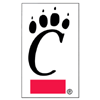|
|
HOME ~ College Football History |
|
Bearcat
football is rich in history and tradition.
The University of Cincinnati football program is one of the nation’s
oldest. When the Bearcats played Miami (O.) on Oct. 24, 1998, UC became
only the 30th program in NCAA Division I-A history to play 1,000
intercollegiate football games.
UC first fielded football teams in 1885, playing against athletic clubs
in the area. Three years later, in 1888, Cincinnati was featured
 in the
very first intercollegiate football game played in the state of Ohio
when a team representing UC visited nearby Oxford to play a team of
students from Miami University. That contest, played on Sept. 24, was
the birth of the rivalry which today ranks as the eighth-oldest and
11th-longest running rivalry in NCAA Division I college football. Only
four NCAA Division I-A schools can boast of football programs older than
Cincinnati's 111 years -- Rutgers, which took part in the nation's very
first college football game in 1869, Michigan, which began play in 1879,
Navy (1880) and Minnesota (1883). in the
very first intercollegiate football game played in the state of Ohio
when a team representing UC visited nearby Oxford to play a team of
students from Miami University. That contest, played on Sept. 24, was
the birth of the rivalry which today ranks as the eighth-oldest and
11th-longest running rivalry in NCAA Division I college football. Only
four NCAA Division I-A schools can boast of football programs older than
Cincinnati's 111 years -- Rutgers, which took part in the nation's very
first college football game in 1869, Michigan, which began play in 1879,
Navy (1880) and Minnesota (1883).
College Football Hall of Fame coach Frank Cavanaugh began his 24-season
career at Cincinnati.
Sid Gillman, a member of the College and National Football League hall
of fame shrines, was the architect of one of the top eras of Cincinnati
football history. He directed the Bearcats to three conference titles
and a pair of bowl game appearances during his six seasons (1949-54)
before leaving for the professional ranks.
That coaching tradition has continued. Three current and three recent
college head coaches have Cincinnati coaching and/or playing
backgrounds, while six NFL head coaches have come through the UC ranks.
Cincinnati, with Gillman developing the passing offenses which would
make him successful in the pro ranks, became known for its aerial attack
in the early 1950’s. That notoriety continued.
In 1968, the Bearcats were the nation’s top passing team. Quarterback
Greg Cook was the NCAA’s total offense leader with receiver/kicker Jim
O’Brien the national scoring champ. A year later, Cook earned Rookie of
the Year honors as a Cincinnati Bengal. Two years later, O’Brien kicked
the game-winning field goal for the Baltimore Colts in the Super Bowl. A
third member of that passing tribunal, Tom Rossley, is now the head
coach at Southern Methodist.
With 80 players advancing into the professional ranks, 30 earning
All-American honors and 11 garnering Verizon Academic All-America
recognition, Cincinnati football clearly has a history of
accomplishments, both on and off the gridiron.
Why Bearcats?
The University of Cincinnati Bearcats were born on Oct. 31, 1914. The
occasion was a football game with the University of Kentucky Wildcats, a
star UC player named Baehr, a creative cheerleader and a talented
cartoonist.
During the second half of that hard-fought football game, UC cheerleader
Norman "Pat" Lyon, building on the efforts of fullback Leonard K.
"Teddy" Baehr, created the chant: "They may be Wildcats, but we have a
Baehr-cat on our side."
The crowd took up the cry: "Come on, Baehr-cat!"
Cincinnati prevailed, 14-7, and the victory was memorialized in a
cartoon published on the front page of the student newspaper, the weekly
University News, on Nov. 3. The cartoon, by John "Paddy" Reece, depicted
a bedraggled Kentucky Wildcat being chased by a creature labeled
"Cincinnati Bear Cats".
The name stuck, but not immediately. Following Teddy Baehr's graduation
in 1916, the name dropped out of use, at least in print, for a few
years. On Nov. 15, 1919, Cincinnati played at Tennessee. Cincinnati
Enquirer writer Jack Ryder's dispatch on the game was the first time
that the major media called UC's teams "Bearcats." From then on, the
university's teams were regularly called Bearcats.
What is a bearcat?
The word first appeared in print circa 1889 as a synonym for the giant
panda. "Bearcat" is a simple translation of the Chinese word for panda (xiong
mao) which means "bear-cat". By 1895, naturalist H. N. Ridley reported
that the binturong, a large cat from Malaysia, was known as the
"bear-cat". There is a binturong at the Cincinnati Zoo which frequents
UC games.
Home Page 
|

 in the
very first intercollegiate football game played in the state of Ohio
when a team representing UC visited nearby Oxford to play a team of
students from Miami University. That contest, played on Sept. 24, was
the birth of the rivalry which today ranks as the eighth-oldest and
11th-longest running rivalry in NCAA Division I college football. Only
four NCAA Division I-A schools can boast of football programs older than
Cincinnati's 111 years -- Rutgers, which took part in the nation's very
first college football game in 1869, Michigan, which began play in 1879,
Navy (1880) and Minnesota (1883).
in the
very first intercollegiate football game played in the state of Ohio
when a team representing UC visited nearby Oxford to play a team of
students from Miami University. That contest, played on Sept. 24, was
the birth of the rivalry which today ranks as the eighth-oldest and
11th-longest running rivalry in NCAA Division I college football. Only
four NCAA Division I-A schools can boast of football programs older than
Cincinnati's 111 years -- Rutgers, which took part in the nation's very
first college football game in 1869, Michigan, which began play in 1879,
Navy (1880) and Minnesota (1883).